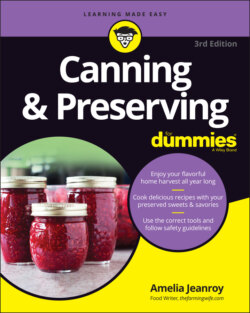Читать книгу Canning & Preserving For Dummies - Amelia Jeanroy - Страница 64
Water-Bath Canning in a Nutshell
ОглавлениеWater-bath canning, sometimes referred to as the boiling-water method, is the simplest and easiest method for preserving high-acid food, primarily fruit, tomatoes, and pickled vegetables.
To water-bath can, you place your prepared jars in a water-bath canner, a kettle especially designed for this canning method (see the section, “Key equipment for water-bath canning,” for more on the canner and other necessary equipment). You then bring the water to a boil and maintain that boil for a certain number of minutes, determined by the type of food and the size of the jar. Keeping the water boiling in your jar-filled kettle throughout the processing period maintains a water temperature of 212 degrees. This constant temperature is critical for destroying mold, yeast, enzymes, and bacteria that occur in high-acid foods.
Water-bath canning is one of the two recommended methods for safely home-canning food (the other method is pressure canning, covered in Chapter 9). Although each processing method uses different equipment and techniques, the goal is the same: to destroy any active bacteria and microorganisms in your food, making it safe for consumption at a later time. This is accomplished by raising the temperature of the food in the jars and creating a vacuum seal.
Water-bath canning and pressure-canning methods aren’t interchangeable because the temperature of a water bath only reaches 212 degrees, while the temperature of a pressure canner reaches 240 degrees, the temperature necessary to safely process low-acid foods. Boiling for any amount of extra time should not replace the higher temperature of a pressure canner. For more on pressure canning, go to Chapter 9.
